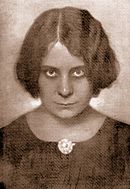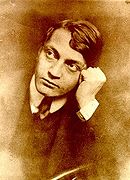- Margit Kaffka
-
The native form of this personal name is Kaffka Margit. This article uses the Western name order.
Margit Kaffka (10 June 1880 – 1 December 1918) was a Hungarian writer and poet.
Called a "great, great writer" by Endre Ady, she was one of the most important female Hungarian authors, and an important member of the Nyugat generation. Her writing was inspired by József Kiss, Mihály Szabolcska, and the writers' group of the periodical Hét.
Contents
Life
Margit Kaffka was born on June 2, 1880 in Nagykároly (today Carei, Romania). Her father was a public prosecutor, but died early on, so the family lived in poverty. With a scholarship, she learned in the Sisters of Mercy teacher's training college in Szatmár; in return, she taught for one year in Miskolc. She studied in Budapest later on, gaining a teacher's diploma in Erzsébet Girl's School. She returned to Miskolc, where she taught literature and economy in a private girl's school, beloved by students. This is the period when her first writings, poems and novels appeared, and she became a full-time contributor to Nyugat, the most important periodical of the era.
She married Brúnó Fröhlich, a forest officer, on February 17, 1905. In 1907 her husband was placed to the Ministry of Agriculture, so Kaffka was able to disconnect from Miskolc, a town she did not like. However, their marriage became stressed after a few years, and ending in a divorce. She was working as a teacher in Budapest between 1910–1915, marrying a second time on August 18, 1914, to the younger brother of Béla Balázs, Ervin Bauer. In the beginning of the First World War, she left her teaching job to live only for literature.
After the war, she became victim to the 1918 flu pandemic along with her young son.
Literature
Her works dealt mostly with two main themes: the fall of the gentry, and the physical and spiritual hardships of the independent women in the turn of the century. She often wrote about her personal memories of great national crises, the glaring oppositions of the anachronistic society in Hungary.
Her literary career can be divided into three chapters, from 1901 to the start of Nyugat in 1908, the second ending in the start of the war in 1918, the third marked by the hard years after the war, ending in her death.
1912 marked the release of her first, and most important novel, Színek és Évek (Colors and Years) dealing with the fate of the gentry class and women. Her second most famed work is Hangyaboly (Ant nest), collecting her memories from the years at Sisters of Mercy, published in 1917.
Major works
- Versek (1903)
- Levelek a zárdából (diary novel, 1904)
- A gondolkodók és egyéb elbeszélések (narratives, 1906)
- Csendes válságok (narratives, 1909)
- Képzelet-királyfiak (meseregény, 1909)
- Csendes válságok (narratives, 1910)
- Csonka regény és novellák (narratives, 1911)
- Tallózó évek (poems, 1911)
- Utolszor a lyrán (poems, 1912)
- Süppedő talajon (narratives, 1912)
- Színek és évek (novel, 1912)
- Mária évei (novel, 1913)
- Szent Ildefonso bálja (narratives, 1914)
- Két nyár (novel, 1916)
- Állomások (novel, 1917)
- Hangyaboly (novel, 1917)
- Kis emberek barátocskáim (collection of early works, 1918)
- Az élet útján (poems, 1918)
- A révnél (narratives, 1918)
Sources
- Magyar életrajzi lexikon (Akadémiai Kiadó, Budapest, 1967)
- Kárpáti Béla: Miskolci irodalom, irodalom Miskolcon (Miskolc, 1989 ISBN 963-02-7150-8)
- A magyar irodalom története 1905-1919 (Budapest, 1965. ISBN 963-05-3592-0)
Categories:- Hungarian writers
- Hungarian poets
- People from Carei
- Deaths from influenza
- Infectious disease deaths in Hungary
- 1880 births
- 1918 deaths
Wikimedia Foundation. 2010.


